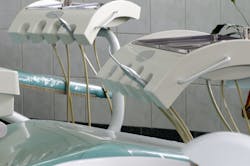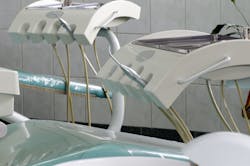Update on surface disinfectants and treatment room asepsis
By Mary Govoni, CDA, RDA, RDH, MBA
As you know, there are several key factors that influence the amount of contamination that occurs during treatment – from spatter, aerosol, or touching with contaminated (gloved) hands. The use of high-volume evacuation and dental dams has been shown to significantly reduce the spatter and aerosols created by handpieces, air/water syringes, and sonic/ultrasonic scalers.
Although a dental dam is not applicable in all procedures, it certainly warrants consideration as an excellent infection control tool. When dentists are using handpieces and creating aerosols, they typically have a dental assistant who uses the HVE. The challenge in controlling aerosols typically falls on the hygienists, who do not typically have an assistant to suction for them.
Two excellent solutions to this challenge are the Hammer Head suction mirror from EMS Systems and the Mirror Suction from Hager Worldwide. These devices can be used with low- and high-volume evacuation systems via the mirror handle. The mirror head has openings on the sides and back surfaces to allow fluids to be evacuated from the mouth. Both the mirror heads and handles are autoclavable. These devices are not only great infection-control aids but efficiency tools as well.
Other key elements in the prevention of cross-contamination in treatment rooms are equipment and surface barriers, as well as surface disinfectants.
It is important to note that if equipment and surfaces are covered with impervious barriers such as plastics, and the barriers have not been torn or compromised during treatment, the equipment and/or surfaces do not require the use of a surface disinfectant after use. Only replacement of the barrier with a clean one is required.
There are easy-to-use barriers for virtually everything in the dental operatory: X-ray sensors, light handles and switches, intraoral cameras, curing lights, caries detection devices, and chair switches.
Kerr Total Care has a comprehensive line of products in its Pinnacle line, Certol has its ProBarrier line of products, and Crosstex has a comprehensive line of surface and equipment barriers.
There are some environmental concerns regarding the disposal of the many barriers used in a dental facility on a daily basis. But this can be offset by the decreased use of chemicals for disinfection and perhaps instituting a recycling program for other materials in the practice. In some cases, the use of cloth barriers may be used.
These barriers can be laundered and reused; however, the cloth may not be impervious and a disinfectant must be used when the barrier is removed. In addition, laundering the cloth barriers consumes electric and water resources. I find that most dental practices try to find a balance between the use of barriers and disinfectants.
Dental teams have many choices of disinfecting products to use for decontamination. CDC guidelines state that the disinfectant should be tuberculocidal when there is blood present or there is the possibility for blood to be present on a surface. One can easily determine if a disinfectant meets this requirement by reading the label or by researching the product on the manufacturer's website.
Other criteria for selecting disinfectants may include contact time (the time it takes to kill mycobacterium tuberculosis) on a surface, alcohol content (lower or no-alcohol products are less damaging/drying to equipment), whether it comes premixed or requires mixing, and a more recent development – a one-step vs. a two-step product.
One-step products are fast and convenient and appropriate to use when there is a low level of contamination. This means that the surface can be cleaned and wiped in one step instead of two (preclean, then second wipe to disinfect). Some examples of one-step (and tuberculocidal) products are: BioSURF from Micrylium, OPTIM 33 TB from SciCan, CaviWipes 1 from Metrex, and STERIPLEX from sBioMed.
Options are a great thing in any situation. In dentistry, we have many good options for infection prevention.Mary Govoni, CDA, RDA, RDH, MBA, is the owner of Mary Govoni & Associates, a consulting company based in Michigan. She is a member of the Organization for Safety, Asepsis and Prevention. She can be contacted at [email protected] or marygovoni.com.
Past DE Articles


